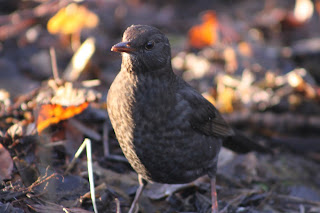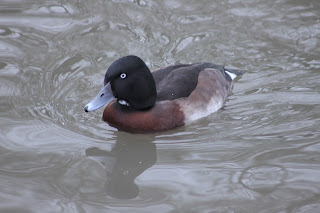Taking advantage of a dry Boxing Day afternoon, I took myself off to Pwll Waun Cynon nature reserve, to have a general look about and see if I could find a few rusts and micro fungi. Arriving at the gate, the sight of a dead cock Pheasant draped over the gate post was a surprise and entering the reserve I was confronted by mud; lots of mud. Thankful that I had chosen to wear my wellies, I trudged, slipped and slopped through it, noting, all the while, the fresh growth on some of the wild flowers, such as Creeping Buttercup and Lesser Celandine and that something was already exploiting this unseasonally early growth, for in the leaves of both species, were abundant larval mines of the fly Phytomyza ranunculi.

My macro lens packed in, last week, so I am having to use my ultra wide to short telephoto zoom lens with an extension tube, which means having to get much closer to the subject than usual. That wouldn't be a problem, were it not for that mud, so I had to go searching for something to kneel on and eventually found an old deflated plastic football, but as I could only get one knee on it, I was unable to get down low enough for proper photographs to be taken. As I searched for the knee rest, I noticed several of the Lesser Celandine plants with flowers open: the earliest in the winter I have ever seen them in bloom.
Near the Celandine, my eye was caught by s few small orange red disks in the mud and taking a closer look, I could see that they were the fruiting bodies of the Eyelash fungus (Scutellinia scutelata).
Further north in the reserve, the ground conditions improved and so did my progress. At the nothern end of the reserve meadow, a new pond has been dug, presumably as a dipping pond (I'll have to ask Carys, the warden), which I passed, on my way to the woods.
I spent a couple of hours in the wood, searching the holly and bramble leaves for rusts. The bramble leaves were covered in the distinctive purple spots of the very common rust Phragmidium violaceum and beneath each purple spot, on the underside of the leaf was a fuzzy black dot (not all rusts are rust coloured in all stages), each a mass of the Teliospores. Under the microscope, they are wonderful to look at, as can be seen below.
 |
A photo of the Teliospores of P. violaceum. Taken a couple of years ago, using my
phone, down the microscope eyepiece. |
There was another rust on the bramble, which caused yellow spots on the upper leaf and had dark spots, surrounded by yellow spore masses below the leaf. This might be the common Phragmidium bulbosum, but I haven't had the chance to get it under the microscope yet.
For those of you who prefer your fungi big and bold, there was a fallen, dead hawthorn, which had several fruiting bodies of what I think is Tremella foliacea.
Under most of the holly leaves I turned over, were small gatherings of what I at first took to be tiny Aphids, but turned out to be tiny, globular Springtails. It's impossible to identify them even to genus level from this photo, so they will have to remain unnamed.
 |
The lens/extension tube combo, will allow me to get closer than this, but then
the front of the lens is too close to allow me to use my ring flash. |
Clambering about on a small holly was this Orange Ladybird, which I later saw flying past.
On my way to the reserve, I had stopped to take a photo off the Mountain Ash comprehensive school footbridge. It was intended to compare with a photo I had come across in the RCT photo archive, taken from the same spot in the early 1980s. How a view can alter in thirty years.
 |
| View in 1982/83, I would guess. Pwll Waun Cynon can just be seen across the river |
 |
| 2015. Nothing but trees. |



















































